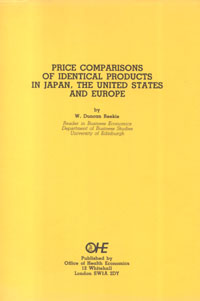Sign up to our newsletter Subscribe
Taking STRIDES: The Value of Diagnostics Against AMR

The promotion of an environment in which the multinational research-based pharmaceutical industry can flourish has been and will continue to be reliant upon a well-informed and widely-disseminated understanding of the economics underpinning its complex operations. Throughout the 1970s OHE has played an important…
The promotion of an environment in which the multinational research-based pharmaceutical industry can flourish has been and will continue to be reliant upon a well-informed and widely-disseminated understanding of the economics underpinning its complex operations. Throughout the 1970s OHE has played an important part in this ‘educative’ process with specific investigations into areas such as the nature of competition within the industry, the use of brand names in prescribing and the role of sales promotion. But it is perhaps the prices obtained by companies for their products that has been at the forefront of concern. The survival of the industry, and hence the well-being of the people it serves, is dependent upon innovation. The latter requires substantial funds to be channelled into research and development activities and this can only be achieved if current sales carry with them an adequate level of return above manufacturing and other costs.
Yet the concept and determination of an appropriate pharmaceutical price level are the subjects of considerable controversy. One source of guidance has been sought through comparisons of international prices. Unfortunately, differences in regulatory/reimbursement systems and in corporate strategies coupled with inconsistencies between methods of administration, dosage strengths and usage patterns of apparently similar products have severely inhibited investigations embracing two or more national markets. The present paper by Duncan Reekie, however, marks a new departure. Drawing upon data made available by eight leading multinational pharmaceutical companies Reekie adopts a unique analytical framework which enables him to compare price levels and to examine the significance of various economic indicators, including exchange rate fluctuations, in generating the differences observed between Europe, the United States and Japan. It is shown that while European prices are very close to those found in the US both are approximately half the levels prevailing in Japan. The significance of this for the future of Japan’s progress in pharmaceutical innovation and its eventual penetration of world pharmaceutical markets needs to be carefully considered.
Although these broad results have been reported elsewhere, OHE considers that the investigation merits publication in its entirety because of its novel and comprehensive methodological approach and its portentous finings. As such the study appears as the first in a new occasional series of Pharmaceutical Industry Research Papers.
Price Comparisons of Identical Products in Japan, the United States and Europe
Reekie, W.D.
(1981) Price Comparisons of Identical Products in Japan, the United States and Europe. OHE Occasional Paper. Available from https://www.ohe.org/publications/price-comparisons-identical-products-japan-united-states-and-europe/